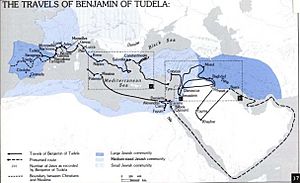Benjamin of Tudela facts for kids
Benjamin of Tudela was an amazing Jewish traveler from the 12th century. He explored many parts of the world, including Europe, Asia, and Africa. His detailed writings about Western Asia came out a hundred years before the famous explorer Marco Polo. Benjamin was very smart and knew many languages. This made him a very important person in the history of travel and Jewish history.
His book, The Travels of Benjamin, is a great source of information. It describes Jewish communities and also gives us a good look at the geography and cultures of the Middle Ages. Many historians today believe Benjamin's descriptions of daily life back then are very accurate. His book was first written in Hebrew. Later, it was translated into Latin and other major European languages. Scholars during the Renaissance (a time of great learning in Europe) were very interested in his work. Benjamin's journeys show us how connected and diverse Jewish communities were during his time.
Early Life
We don't know much about Benjamin's early life. We do know he was from a town called Tudela in what is now Spain. Today, there's a street named after him in the old Jewish quarter of Tudela.
Benjamin's Amazing Journey
Experts aren't completely sure about Benjamin of Tudela's exact travel route. However, most believe he followed popular paths used by travelers at the time. Benjamin started his journey around 1165 from the northeast part of Spain. He might have begun his trip as a pilgrimage (a religious journey) to the Holy Land.
Some people think he also had business reasons for traveling. He seemed very interested in the coral trade, so he might have been a gem merchant. Another idea is that he wanted to list Jewish communities along the way. This list could have helped other Jews traveling to the Holy Land or those escaping difficult situations.
Benjamin often stopped in different places. He met people, visited towns, and described various jobs. He also counted the number of Jewish people in each town and country he visited. He shared his thoughts on the different cultures he met. Sometimes, he even compared their customs to others.
His journey started in Zaragoza, Spain. He then traveled along the Ebro river to Tarragona, Barcelona, and Girona. From there, he went north to France. He then sailed from Marseille. After visiting cities like Genoa, Lucca, Pisa, and Rome in Italy, he traveled to Greece and Constantinople (modern-day Istanbul).
Next, he headed across Asia. He visited Syria, Lebanon, the Land of Israel, and northern Mesopotamia (which he called Shinar). He then reached the famous city of Baghdad. From Baghdad, he went to Persia. After that, he traveled back across the Arabian Peninsula to Egypt and North Africa. Finally, he returned to Spain in 1173.
During his travels, Benjamin described a large Jewish community in a place near modern-day Ethiopia. While we know such a community existed, scholars are still trying to figure out exactly where in Africa he visited. The way names were spelled back then makes it hard to be sure.
Benjamin's visit to the ruins outside Mosul is one of the first accurate descriptions of the ancient city of Nineveh. He visited about 300 cities in total. Many of these cities were important in Jewish history, like Susa, Sura, and Pumbedita. He also gathered information about many other places he heard about, including China and Tibet. He wrote about different cultures, like the Al-Hashishin (hemp smokers). He introduced people in Western Europe to places and cultures far beyond what they knew.
He wrote about his travels in a book called The Travels of Benjamin. This book describes the countries he visited. He focused on the Jewish communities, including how many people lived there and the names of important leaders. He also described the customs of both Jewish and non-Jewish people, especially city life. Benjamin wrote about Baghdad with great excitement. He especially noted the kindness of the Caliph (the ruler). He often wrote about the respect and mixing he saw between Jewish people and Muslims. He gave detailed descriptions of landmarks and important buildings he saw.
Historians generally trust Benjamin's accounts. However, some of his claims might have come from earlier writers. For example, his idea that Laish (Tel Dan) was the same as Baniyas is not correct.
Remembering Benjamin
Another traveler and writer in the mid-1800s used the name Benjamin II to honor Benjamin of Tudela.
A famous Russian Jewish writer from the 1800s, Mendele Mocher Sforim, wrote a book in 1878 called The Wanderings of Benjamin III. This book is like a Jewish version of Don Quixote. Its title was clearly inspired by Benjamin of Tudela's book.
There's a street named after him in Jerusalem's Rehavia neighborhood. His hometown of Tudela also has a street and a high school named Benjamín de Tudela after him.
The well-known Israeli poet Nathan Alterman wrote a poem about Benjamin of Tudela. It was set to music by Naomi Shemer and was often played on Israeli radio.
Uri Shulevitz wrote and illustrated a children's book about him in 2005. It's called "The Travels of Benjamin of Tudela. Through three continents in the twelfth century."
See also
 In Spanish: Benjamín de Tudela para niños
In Spanish: Benjamín de Tudela para niños



